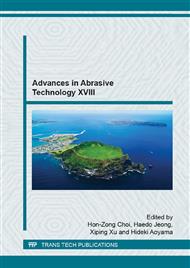p.78
p.84
p.90
p.97
p.104
p.113
p.119
p.125
p.131
Recyclability and Performance Stability of Corrosion Inhibition Improved Amine-Free Water-Soluble Cutting Coolant
Abstract:
The concern for environmental problems has been increasing rapidly in recent years. Water-soluble coolants are widely used in machining processes. To reduce management costs and the environmental load of water-soluble coolants, the authors studied a recycling system for water-soluble coolants. With this recycling system, water is extracted from a waste coolant by chemical or biochemical treatment; the recovered water is re-utilized as a diluent for a new coolant. Coolant recyclability depends on the coolant type. Most water-soluble coolants contain alkanolamines for corrosion inhibition and maintenance of putrefaction prevention. However, alkanolamines are difficult to eliminate from water-soluble coolants by chemical and physical waste treatment processes. Some amine-free, water-soluble coolants have been developed and are commercially available. The reduction of environmental load in the treatment of waste coolants is anticipated for amine-free coolants. We applied the recycling process to a commercially available amine-free, water-soluble coolant. The amine-free coolant showed good recyclability and lubricating performance. However, the corrosion inhibition performance of the coolant was inadequate for use in general machining. Recently, our cooperative company developed a prototype amine-free, water-soluble coolant with improved corrosion inhibition. In this study, we experimentally examined the recyclability and performance stability of this newly developed coolant. The experimental results showed that the new amine-free coolant has good corrosion inhibition equivalent to conventional amine-containing coolants. In addition, the recyclability, stability, and cooling and lubricating performance of the coolant are equal to conventional amine-free coolants. The amine-free, water-soluble coolant with improved corrosion inhibition has the advantage that it can be used in the recycling system for water-soluble coolants.
Info:
Periodical:
Pages:
104-109
Citation:
Online since:
January 2016
Keywords:
Price:
Сopyright:
© 2016 Trans Tech Publications Ltd. All Rights Reserved
Share:
Citation:


